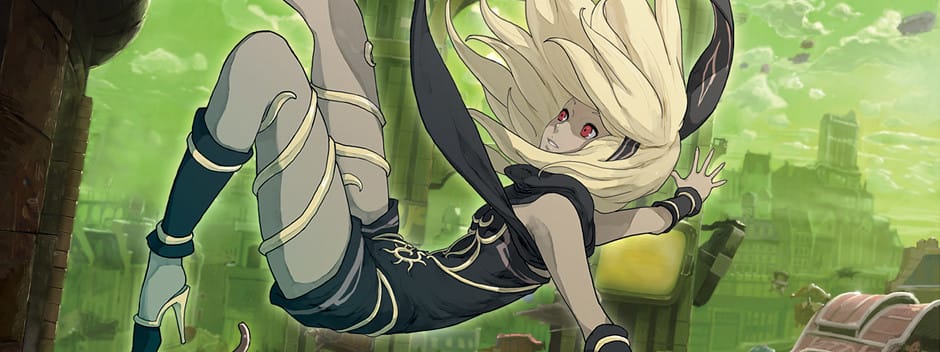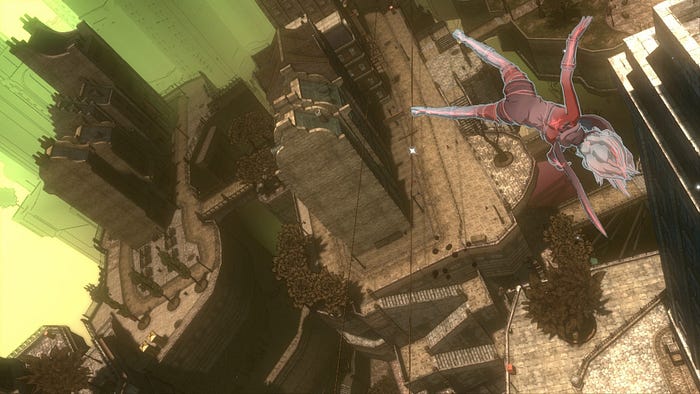Revisiting Gravity Rush
Why this criminally forgotten game is one of the best

I can’t remember a time where I didn’t dream of falling through the sky. Video games have long afforded us access to the impossible. We can fight dragons, attain superpowers, manipulate time, wield incredible weapons. Something as absurd as flight has long been simple in the realm of gaming, that oh-so-revered superpower that we all wish we had. If we could touch off the edge of a skyscraper and invert ourselves into the blue abyss we would do it in a heartbeat.

Falling through the sky
In 2012, Team Gravity released a game on the PlayStation Vita entitled Gravity Rush (Gravity Daze in Japan). In the game, players controlled a lonesome hero named Kat who could manipulate gravity and use her powers to save the steampunk metropolis of Hekseville from the invasive, eldritch Nevi menace. Using a mixture of the Vita’s innovative gyro controls and rear touch pad, Gravity Rush felt like no handheld game before it — not to mention that its gorgeous cell-shaded graphics and unusual gameplay made for a memorable experience.
Interestingly, Gravity Rush was directed by Keiichiro Toyama of the beloved Silent Hill franchise. Despite some impressive technical challenges due to the chosen hardware, Gravity Rush released as a labor of love, a game specifically designed for the handheld by Toyama as a unique experience. Gravity Rush’s world is a beautiful palette of impressive design and vertical, upper-atmosphere worldbuilding that drew from the work of French artist Jean Giraud. Its mix of cutesy anime tropes and crunchy Western steampunk resulted in a game world that, to this day, feels wholly original.
Both Gravity Rush and Gravity Rush 2 are phenomenal games. They sold an underwhelming amount of copies, and despite Gravity Rush 2 being released the same year as The Legend of Zelda: Breath of the Wild, Nier: Automata and Horizon: Zero Dawn, it has largely been forgotten in the last half decade.
Gravity Rush, one of the most unique action platformers ever to exist, deserves better than this.

Second chance
In 2016, not long before the release of Gravity Rush 2, BluePoint Games (of Shadow of the Colossus remaster and Demon’s Souls remaster fame) released a high-definition remaster of the Vita game for the PlayStation 4. Faithful to the original in every aspect, the remaster of Gravity Rush did what the original couldn’t do: it brought the titanic and beautiful adventure to a system that could handle its majesty. Gravity Rush remaster included all the Vita DLC and succeeded Toyama’s wish of bringing the game to a wider, more accepting audience. The frame rate was increased. The lighting, blur effects, and draw distance were improved. Most importantly the game had an upgraded graphics engine that made the character models pop. Overall, Gravity Rush was both a beautiful and faithful remaster that whetted appetites for the upcoming Gravity Rush 2.
It’s impossible for any fan of Gravity Rush to mention the game without talking about its incredible, jaw-dropping gameplay. To call Gravity Rush and Gravity Rush 2 unique undersells them — they’re unlike any other action platformer I’ve ever played. Much of it is typical fare; Kat can run, kick, jump, and explore. Gravity Rush is a platformer of old where we are guided to collect thousands of sparkly, glowing baubles. What makes the games stand out is the vibrant mechanic of controlling Kat’s gravity, and all the various ways the series uses this mechanic to spark creative interactions in movement, platforming, combat, puzzles, and more.
Kat navigates the floating steampunk structures of Hekseville by using her impressive array of gravity powers. On the Vita, players would control her by tilting the system to aim her and then allowing her to “fall” in the chosen direction by turning her gravity on and off. Using her abilities, Kat can walk on vertical surfaces, fly, float, grab and throw objects, and more. A regenerating bar is tied to the use of her gravity, and as players direct her to sail through the skies the length of time she can fly and use her gravity powers grows. Hekseville is enormous (and even bigger in Gravity Rush 2), and the addicting use of gravity powers engenders player exploration throughout the ruined citadels, busy town squares and floating islands of the world.
Combat is a natural extension of the platforming and gravity abilities; while Kat is able to simply attack foes via physical strikes, the gravity manipulation allows her to rotate around foes and find their weak spots. Dropping Kat on an enemy’s weak point from high up is incredibly satisfying.

Gravity queen
Gravity Rush’s most overlooked feature is the plot between the two games. Its scenes are bright, and narration is often delivered through comic book style exposition. While the world and characters are brilliantly designed, there is an existential melancholy to the happenings of both games. Kat is an outcast who exists between the oppressed villagers and their struggle against the terrifying intent of the overpowered military. Kat is labeled the “Gravity Queen” and becomes a homeless superhero of sorts, rescuing the citizens of Hekseville from the Nevi for little to no payment. As she explores the city with her cat Dusty, she ascends from the simple tasks of saving townspeople to fighting against Nevi-enhanced military operations. Eventually she confronts a fellow Shifter named Raven, and they eventually overcome their archrival status in order to work together to save the town.
Here’s the thing: Kat isn’t a badass. She isn’t really even a superhero. She’s a normal, confused girl who’s trying to navigate life while tied to the overwhelming strangeness of her unique abilities, and she’s doing her best to try and help people along the way.
Hekseville contains many mysteries, from its overeager military presence to the World Pillar to why it floats in the sky at all. As Kat’s fight against the Nevi intensifies, she’s forced to learn more about her past, and about the city’s crimes against its own people. Each and every fight culminates in spectacular moments of platforming action, and with every success, Kat and Raven’s gravity powers increase, and their understanding of the dark truths behind Hekseville grow.
I deeply love Gravity Rush. Its lack of popularity baffles me; I can only determine it to be “one of those things.” Was it the initial release on the Vita? Was it the poor release schedule? Was it how it had to compete with other, more popular titles? Gravity Rush was conceived as a dream project of Toyama, who wanted to design a project that would exist outside the scope of his horror game past. Despite the difficulties his team faced in developing the title for the Vita, the original release of Gravity Rush resulted in a fun and memorable game. The concurrent PlayStation 4 releases of Gravity Rush and Gravity Rush 2 only cemented the games as possible bonified hits for Sony.
It just never happened.

Dreams and desires
The Gravity Rush games may remain forever stuck in gaming limbo, celebrated profusely by their fans but largely ignored by everyone else. Despite the games being regularly (and heavily) discounted during PSN sales, not much has ever pushed the needle. Gravity Rush even received a small but entertaining OVA in 2016 preceding the release of the second game.
I think the reason that Gravity Rush has so long stayed in my consciousness is that, like most of my favorite video games, it attempted to do something different. Video games are inarguably more than simple entertainment; they contain multitudes. Video games are interactive stories. They’re novels that let you tilt your protagonists forward and back, left and right. Gravity Rush, at its absolute high, gave me a feeling that no open world game ever has — it presented me a full and interesting world where I was not limited by my physicality. Allowing Kat to tumble through the sky, wind whipping through her hair and oscillating around the curve of her shoulders and hips, only to bring her gravity powers online and send her careening into the particolored blue and white abyss is a feeling of open serenity unmatched even by Sony’s recent Spider-Man games.
Playing Gravity Rush just feels good. Hopefully, someday soon, we can fall through the sky with Kat once again.
